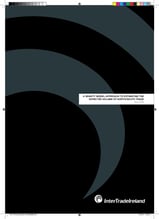Published: May 2009
Executive Summary
The international literature shows that there are significant gains from trade, particularly in raising productivity and driving growth. These arise from a number of sources. For example trade increases competition, which in turn results in higher efficiency and consequently overall growth in economic activity. Trade also results in technology transfer, both in relation to final goods and intermediate inputs. A high-tech machine that is imported will produce output more efficiently. Likewise high-tech components that cannot be sourced locally can, if imported, be used to produce a higher value output. Trade can also foster other relationships between firms such as R&D co-operation.
In this context this report aims to assess whether aggregate and sectoral cross-border trade between Ireland and Northern Ireland is at, above or below the expected level. As such the analysis provides a vital input into the formulation and targeting of policies to promote trade and business development on the island of Ireland and will specifically help in targeting policy interventions as part of the InterTradeIreland trade and business development programmes.
The deviations of actual trade from the expected level is estimated using a gravity model which accounts for the key factors that determine the level of trade flows between trading partners. The model is estimated using a large panel data set covering the 42 most important trading partners of Ireland.
The key finding is that once important economic and geographic factors are taken into account, the level of trade between the two jurisdictions is below the expected level. This finding applies to both total manufacturing trade and the trade for a number of sectors (See Box 1). It is shown that the gap between the actual and the expected level of trade is increasing. For total manufacturing trade over the period 1998 to 2007 the gap between expected and actual North to South trade was 82 per cent while for South to North trade it was 77 per cent.
While the analysis was focused on establishing whether the level of trade between Ireland and Northern Ireland is above, at or below the expected level, the report also highlights a number of possible explanations. The findings may be explained, at least partly, by the fact that the economies of the two jurisdictions are quite different. Ireland for example, is more outwardly orientated, which is related to the degree to which multinational enterprises dominate a number of sectors.
Consequently, it is not surprising that in a sector such as Electrical and Optical Engineering, which is dominated in Ireland by foreign multinational enterprises, the level of trade is significantly below the expected level. For some sectors such as Food and Beverages and Non-Metallic Minerals, the level of trade was found at about the expected level, which reflects the nature of the goods traded.
The results of the research have important policy implications:
- The fact that there is a gap between the actual and expected level of trade highlights that there are substantial potential gains from trade to be exploited on the island of Ireland.
- The unexploited gains from trade are increasing since the gap between the actual and expected level of trade is increasing.
- The results highlight the need for appropriate policy measures to increase the level of cross-border trade on the island of Ireland, though more detailed analysis may be required to identify such measures, particularly at sectoral level.
- The fact that some sectors trade at the expected level, does not imply that policies to further increase the level of trade are not warranted. The expected level should be seen as a lower bound target for policy.
- The analysis in this report focused on manufactured goods, since the data to carry out a similar analysis for services trade is not available. Given the increase in services trade, it is vitally important to address the issue of data availability.
Box 1:
Summary Results for each Sector
Food, Beverages and Tobacco - This sector trades at about the expected level. This is likely to be due to similar tastes across both jurisdictions, a greater level of interaction at the firm level and the need for freshness.
Textiles and Leather - This sector trades below the expected value. A possible explanation is the importance of a small number of large customers which are largely based in Great Britain (GB) or abroad.
Wood - This sector trades below the expected level. A possible explanation is a heavy focus on production for local markets only.
Paper and Publishing - This sector trades below the expected level. For South to North trade this is likely to be related to reproduction of recorded media (incl. software) which is dominated by multinationals.
Chemicals - This sector trades below the expected level. This is likely to be driven by the high
share of multinationals which are serving world markets from their production bases on the island.
Rubber and Plastics - This sector trades below the expected level. Production is either focused on local markets or at world markets.
Non-Metallic Minerals - This sector trades at about the expected level, primarily due to the low
value to weight ratio.
Basic Metal products - This sector trades below the expected level. Production is either focused on local markets or at world markets.
Machinery and Equipment - This sector trades below the expected level. Production is either focused on local markets or at world markets.
Electrical and Optical Equipment - Trade is well below the expected level. This is likely to be driven by the high share of multinationals which are serving world markets from their production bases on the island.
Transport Equipment - This sector trades below the expected level. Production is either focused on local markets (e.g. building and repair of pleasure boats) or at world markets (e.g. shipbuilding, or aircraft & aircraft parts).
Click here to download the full report: A GRAVITY MODEL APPROACH TO ESTIMATING THE EXPECTED VOLUME OF NORTH/SOUTH TRADE

